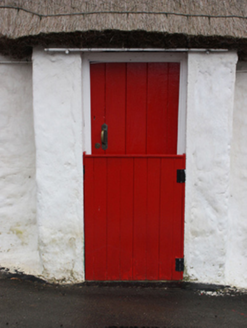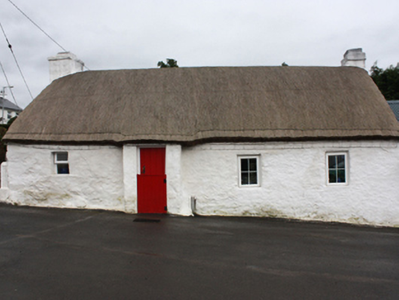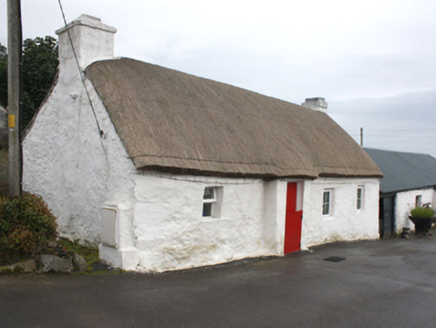Survey Data
Reg No
40810001
Rating
Regional
Categories of Special Interest
Architectural, Technical
Original Use
House
In Use As
House
Date
1780 - 1840
Coordinates
264611, 440558
Date Recorded
18/09/2008
Date Updated
--/--/--
Description
Detached three-bay single-storey vernacular house, built c. 1820 and extended c. 1860, having single-bay windbreak porch to the front elevation (south), and with multiple-bay single-storey outbuilding(s) attached to the east gable end. Pitched/domed thatched roof having ropes and wire mesh over secured on metal bar below eaves level, and with rendered chimneystacks to the gable ends. Roughcast limewashed rubble stone construction. Square-headed window openings with no sills and with replacement fittings. Square-headed door opening to front face of porch having battened timber half-doors, and with battened timber gate to exterior. Set back from road, aligned at a right-angle to the road-alignment, to the north-east end of Greencastle. Tarmacadam yard to site. Single-storey outbuilding attached to the east, possibly formerly a dwelling, having pitched corrugated-metal roof, limewashed rubble stone walls, and square-headed openings.
Appraisal
This charming and well-maintained thatched vernacular house retains its early form and character, and is an appealing feature in the landscape to the north of Greencastle. The irregularly-spaced small window openings and the limewashed rubble stone walls help to create an appealing composition with a strong vernacular character. It probably originally dates to the first decades of the nineteenth-century (depicted on Ordnance Survey first edition six-inch map of c. 1837). Modest in scale, it exhibits the simple and functional form of vernacular building in Ireland. Of particular interest in the survival of the thatch roof, although recently renewed, which is now sadly becoming increasingly rare in Donegal. The rounded roof is a typical feature of thatched houses located close to the sea in exposed areas in the north-west of Ireland, while the metal bars to the eaves were used to tie ropes (and sometimes nets) over the roof to secure it against the prevailing winds, as is the case here at Greencastle (Eleven Ballyboes). The loss of the original fabric to the openings fails to detract from its integrity and visual appeal. The windbreak porch is a feature of many vernacular dwellings in Donegal while the building is aligned at a right-angle to the road alignment, a feature of many vernacular houses in Ireland. The form of this building and location of the chimneystacks suggests that this building is of the ‘direct entry’ type that is characteristic of the vernacular tradition in north-west Ireland, and also suggests that this building may have been extended to the east by a bay at some stage. The substantial single-storey rubble stone outbuilding attached to the east gable end adds considerably the setting and context of this dwelling; this may have been a former dwelling to site. This house represents a fine surviving example of a once ubiquitous building type in the rural Irish countryside, and is one of the better and more attractive surviving examples of its type in County Donegal.





